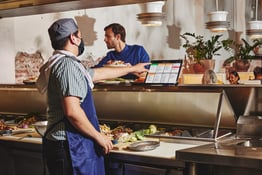On Tuesday, the National Restaurant Association (NRA) released its 2022 State of the Restaurant Industry report, which measures the restaurant industry's continued recovery and examines current and emerging trends to provide a look ahead. The data is based on the latest economic data as well as responses captured from surveys of thousands of restaurant operators and consumers.
We break down the major findings from the report, from telling pandemic recovery and staffing stats to some of the top operational trends expected to grow this year.
Entering a new normal, but path to recovery remains a struggle
As we enter the third year of the pandemic, the restaurant industry continues to face
some of the most challenging business conditions in history. More than half of restaurant operators surveyed believe it will be a year or more before their business conditions return to normal.
The NRA forecasts the foodservice industry to reach $898 billion in sales in 2022. But, when adjusted to inflation, foodservice sales are still down roughly 11% below where they were pre-pandemic. But there’s also optimism on the horizon.
"The restaurant and foodservice industry has adapted and is carrying on with absolute resilience, so we're optimistic about the path toward recovery in the coming year," said Marvin Irby, the NRA’s interim president and CEO. "We still have work to do to ensure that those operators struggling the most can survive. The Association will continue to champion the necessary government support needed at the federal and local levels to help keep these businesses — cornerstones of our communities — on a path to better days."
In good news, consumer demand remains high. According to the report, 51-percent of adults say they aren’t dining at restaurants as often as they’d like, a notable six percentage points higher than when reported in January 2020, before the pandemic. Meanwhile, 63-percent of adults – including 75% of millennials and 70% of Gen Z adults – say restaurants are an essential part of their lifestyle.
Household wealth and savings are well above pre-pandemic levels, and debt levels are lower, which bodes well for continued spending growth, says the association.
Staffing and food costs continue to be a top challenge
While desire to dine out is growing, staffing remains an issue. The restaurant and foodservice industry added back 1.7 million jobs during 2021 for an end-of-year total of 14.5M employees, but seven in 10 operators reported being severely understaffed. The NRA projects the industry workforce to grow by just 400,000 jobs in 2022, for total industry employment of 14.9 million by the end of the year, still a half-million jobs below early 2020 levels.
Roughly half of operators expect recruiting and retaining employees to be their top challenge in 2022. And 75-percent of operators said they plan to devote more resources to this area.
As far as other strains on the industry, food costs take second place. Nine out of 10 operators say their total food costs (as a % of sales) are higher than they were pre-pandemic. And 96-percent of operators reported supply delays or shortages of key food or beverage items in 2021, a problem that’s expected to continue in 2022.
Technology usage ramps up, providing competitive advantage
Amid pandemic challenges, takeout and delivery became key to survival for many restaurants in the past two years. And off-premise sales should continue, says the report. Six in 10 adults say they’re more likely to order either takeout or delivery from a restaurant than they were before the pandemic, including seven in 10 millennials and Gen Z-ers.
Technology platforms have become pivotal to enabling restaurants to meet the thriving off-premise dining demands and also help operators evaluate ways to increase all-around margins. According to the report, more than eight in 10 operators say the use of technology in a restaurant provides a competitive advantage, and a good proportion of operators plan to ramp up investments in technology this year. The most common plans are for service-based technology such as online or app ordering, reservations, mobile payment, or delivery management, says the NRA. Many operators also plan to devote more resources to back-of-the-house technology, such as point-of-sale, inventory, or table management.
With many consumers on board, embracing more tech looks to be a promising investment. According to the report, only about one in four adults think restaurants currently employ too much technology, while the same proportion say they could use some more tech.
Tech options are most popular among younger consumers, the report shows, which could provide an insightful look at the future. It’s especially true when it comes to drones and robots. More than 60-percent of Gen Z and millennials say they’d order delivery that arrives by a self-driving car versus 42-percent of Gen-Xers and 33-percent of Baby Boomers, and roughly 60-percent said they’d get food prepared by automated systems versus 32-percent of Gen-Xers and just 20-percent of Baby Boomers.
Tech might also help alleviate short-staffing crises. Roughly two-thirds of operators say they predict technology and automation will become more common to help with the current labor shortage in 2022.
Outdoor dining, menu streamlining, and other operational takeaways
The past year has also continued to drive consumer demand for alcohol to-go and outdoor dining, with nearly four in 10 consumers saying the availability of outdoor seating would make them more likely to choose one restaurant over another similar one, according to the report. Roughly half of restaurant operators think the availability of seating on a sidewalk, parking lot, or street will become more common this year.
Meanwhile, amid supply chain disruptions and rising food costs, six in 10 full-service operators say their menu is now smaller than it was before the pandemic, and nearly half of fast-casual and quick service operators said they cut items.
Restaurants might find new profit opportunities in meal subscription programs. Fifty-seven percent of adults say they’d likely participate in a meal subscription program if it was offered by one of their favorite restaurants. Eight in 10 millennials and Gen Z adults say they’d use this option. Ghost kitchens could also continue to trend up. Roughly four in 10 operators think delivery from a virtual or ghost kitchen will become more common in 2022.
"While recovery speed varies across the industry by segment, the constant innovation and sustained flexibility of restaurant operators are creating a new future for the restaurant industry,” said Hudson Riehle, senior vice president of the Research and Knowledge Group at the National Restaurant Association. “There will continue to be ample opportunities for growth in 2022 and beyond."
[Photo by Gabriella Clare Marino on Unsplash]





